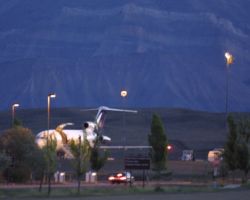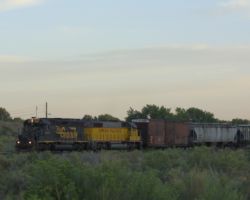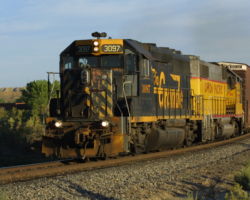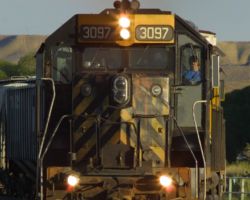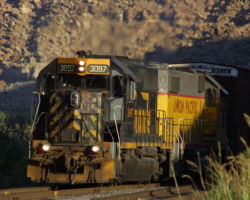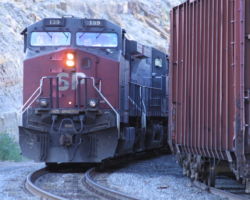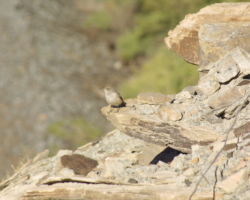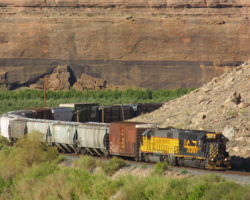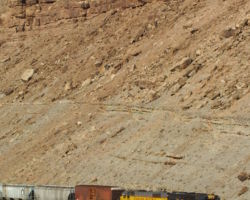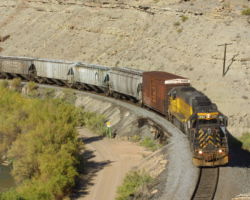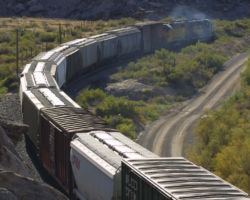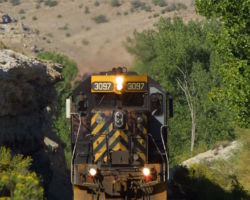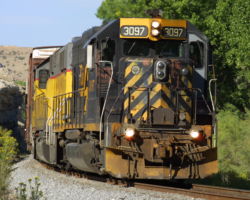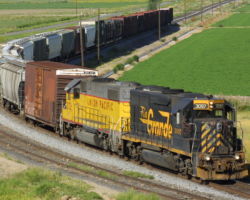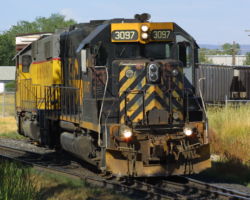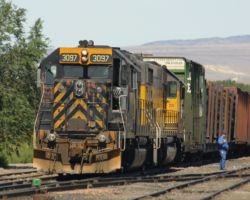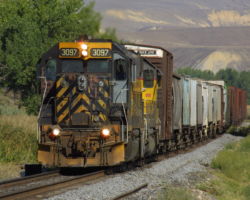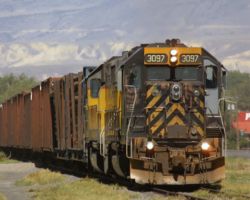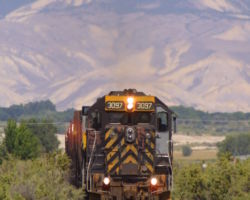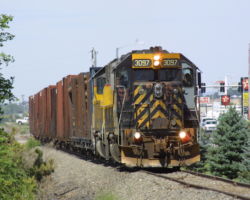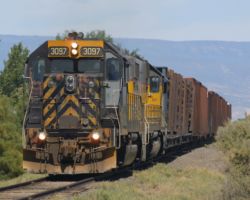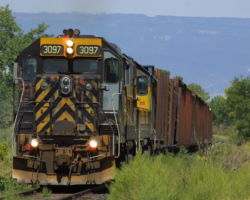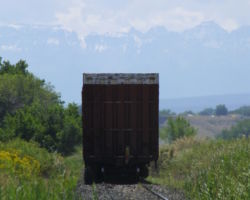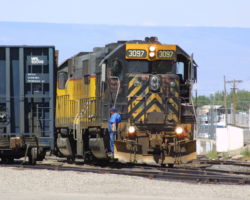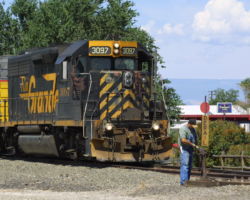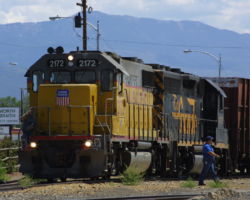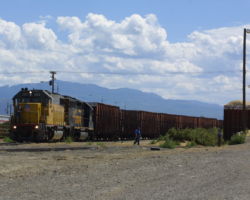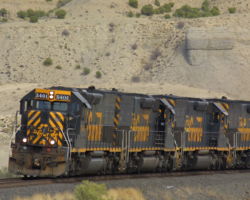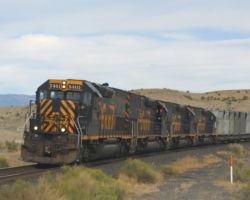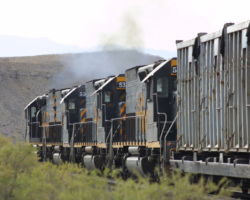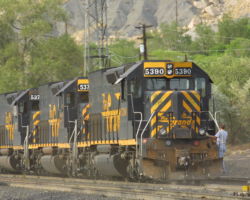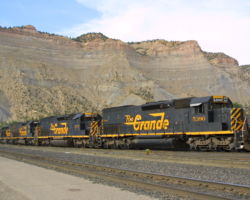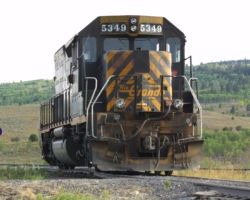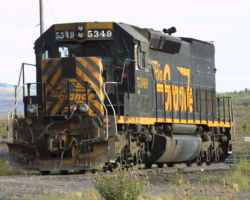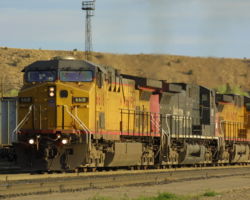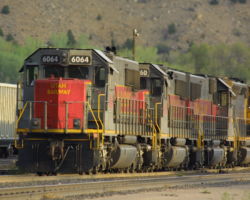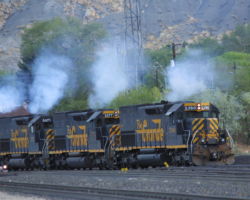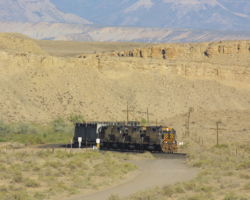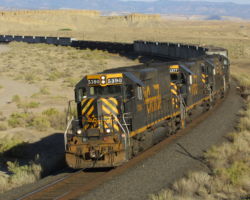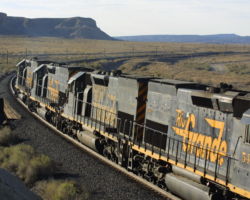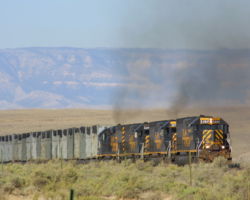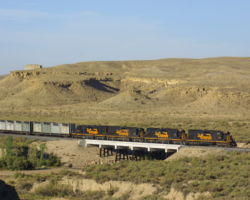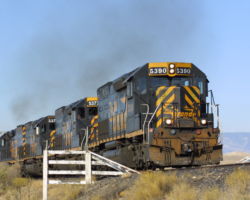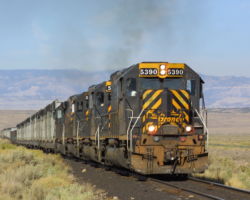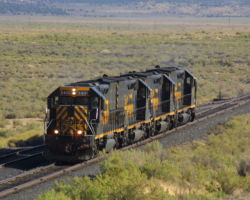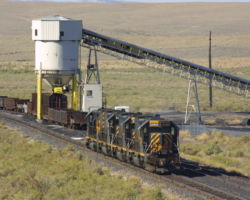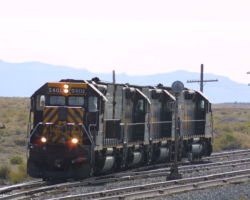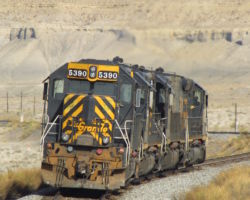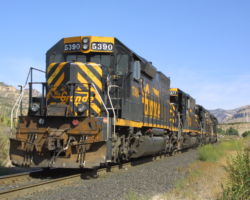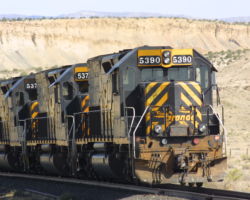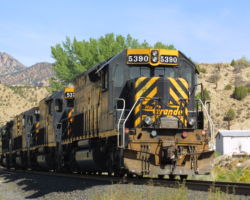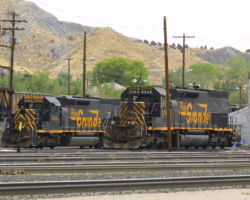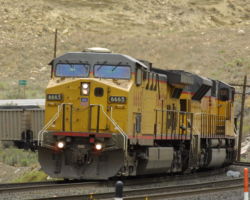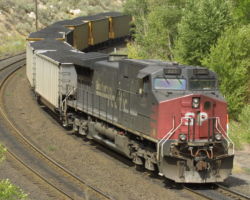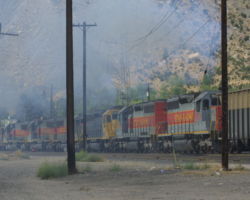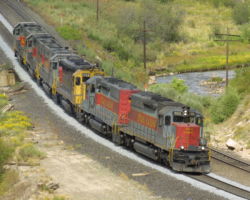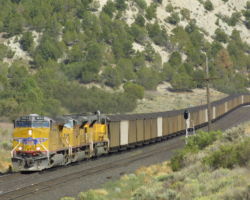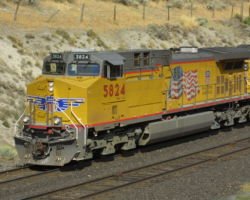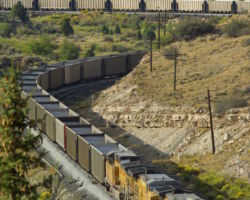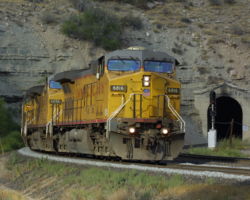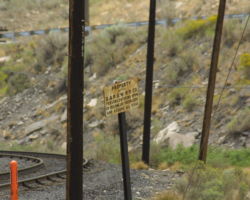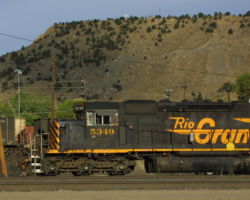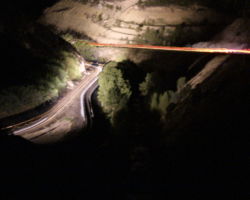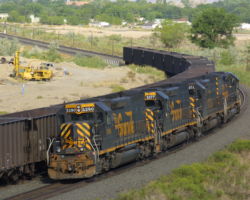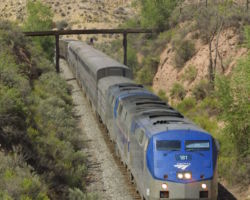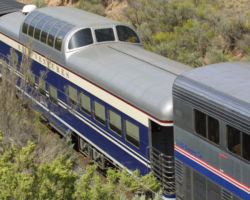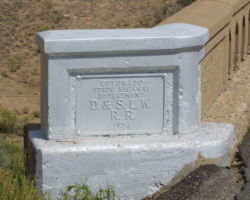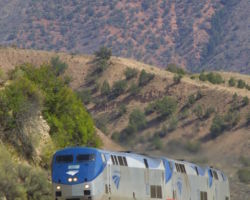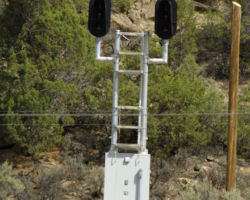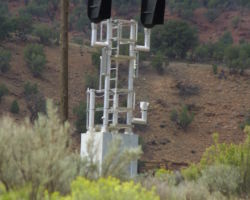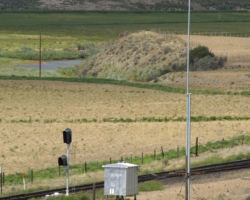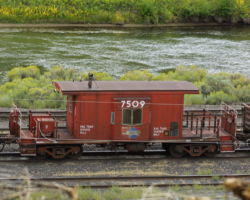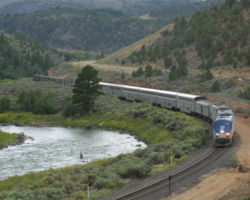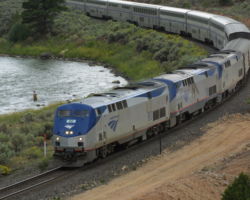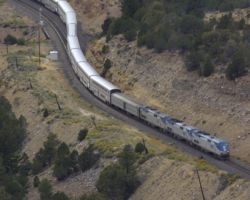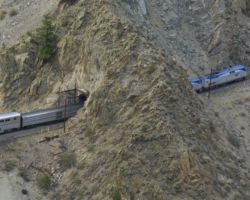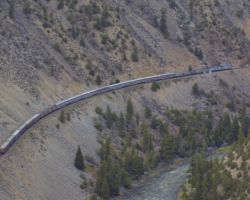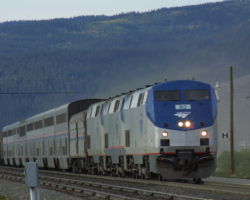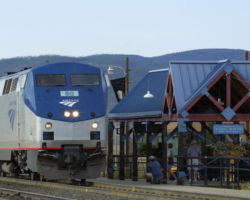I seem to make about three trips to Helper a year. Usually there’s one mid-spring, one in mid-summer, and then one in late fall/early winter, and in early July I realized I was about due for another one. After all, I hadn’t been out since February and I knew things would be changing significantly. After all, the SD40T-2s can’t last forever, and 5390 had been having trouble for some time. Then, from out of the blue, came the news that the Utah, one of my favorite regionals, was being sold to Genesee & Wyoming Inc. I’d actually started planning to get out to Helper again since early August, but various things kept getting in the way. Finally, with Labor Day weekend approaching and a hectic few weeks fast approaching at work, I decided that there’s no time like the present and headed out on Thursday night after work. As usual, I spent the night in Grand Junction to await the departure of the Montrose Local the next morning.
I decided to go as cheaply as I could on this trip, so Motel 6 it was. As luck would have it, I didn’t actually get to bed until around midnight since I made the stupid mistake of booting my laptop and doing a bit of work. The downside to Motel 6 in GJC is that it’s very near the flight path into the airport. Somewhere around 0545h, my alarm went off, followed only thirty seconds later by the roar of a landing jet aircraft. Rattled immediately awake, I stumbled over to the window to peek outside and fumble until I actually got the lights on. Sure enough, even in the morning twilight I would make out the white body and purple tail. Pulling up to the ramp was one of ours – a FedEx 727. Amazing… my first day off in quite a while and what wakes me up anyway… The funny thing is that he’d probably just come in from a stopover in Colorado Springs, if the routes still work like they used to.
After I’d actually propped my eyes open to the point I realized it was nearing 0600h, I shot through the shower, packed up the gear, and headed out. It’s truly amazing just how much gear I carry around for railfanning compared with what I used to have (only a small point and shoot 35mm camera), and how much of that needs a good nightly charging. It’s also amazing how much better it charges when you plug it in – a fact I became woefully aware of when I went to put the batteries in the scanner. There goes $12 down the drain at the local convenience store. Still, the North Fork is entirely dark territory, and your scanner quickly becomes your best friend. No time to bicker over a few dollars for fresh batteries.
By the time I had batteries and a full tank of gas, it was nearing 0630h and I had some concerns that the local had already departed. My fears were alleviated, though, when I met up with DRGW 3097 and train blocking the road in downtown Grand Junction. To my surprise, the last few cars on the train were woodchip hoppers – meaning I’d finally managed to catch one of the elusive Montrose Locals that actually was going to Montrose! For those unfamiliar with this run, the Montrose Local typically stops in Delta, a good solid 20 miles short of the end of the line. The woodchip cars head down to the end of the line empty and are loaded with chips from a local operation. Honestly it’s probably the only thing that keeps the Delta-Montrose segment intact.
I did manage to catch the train just south of Grand Junction, but the sun hadn’t quite broken over the mesas yet. Consequently, it’s barely worth mentioning, aside from the fact I figured out how to get down to that piece of the line. With sunrise coming quickly, I guessed that by the time 3097 made Whitewater the morning light would be darn near perfect for Rio Grande Aspen Gold. There’s a great curve as the line goes through Whitewater, and the warm morning sun makes for a very nice shot. After a short wait, the sun and train both showed up – right on cue. (Photo #1) However, this rapid southbound progress would soon be hindered.
As I’d sat in Whitewater awaiting his arrival, I’d heard quite a bit of chatter on the radio between the DS and two north/westbound coal loads coming off the North Fork. The dispatcher was bringing them up as far as Bridgeport, where the local would go in the hole and wait for both. Even with the stop at Whitewater, I still had plenty of time to get down to Bridgeport and set up. Unlike last year, when I hiked up along the cliffs to the north of the switch and screwed up my knee, I decided to play it safe and just shoot from near the parking area. I also decided I’d be making an experimental effort to add video to my trip reports. I’d pondered it the day before, and purchased a new battery for the camcorder before leaving Colorado Springs. Bridgeport seemed a good first opportunity to try it all out.
I pulled into Bridgeport a few minutes ahead of the local and dug out the tripod, a spare tape, and the camera. The first northbound coal load had just pulled through the east/south switch, and was clearing up his track warrants. Fortunately he stopped quite a way back down the line, not getting into the shot (or onto the audio track) at all. The light was darn near perfect, a fact I just couldn’t believe. I’d never seen such clear skies and perfect light at Bridgeport. (Photo #2) As soon as the local was clear of the switch, the coal load (led by SP 139 – Photo #3) pulled up to the end of the siding, aligned the points for the main, and was quickly off. The engineer was kind enough to lean out the window as he went by to tell me there was another load following close behind. Just a sign this was going to be a good trip – always nice when the crews are friendly.
New Trip Report Feature – Video! Unfortunately, as I turned the video camera on the wind picked up a bit, so there’s a little wind noise on the audio track. Still, my first attempt at posting good video in a trip report comes in at “Photo #3” The high quality video is compressed using what’s known as the DivX codec for video and standard MPEG Layer 3 audio (MP3) – it provides very good quality video and audio compression, and best of all the basic version is free. Currently it’s available for Win32, MacOS 8.6 and later, and Linux. It does require a fairly hefty machine to work well, though, so just be warned. It’s available here. For those of you preferring a smaller download or not having the computing power to use DivX decompression, the lower quality video is formatted for Real Networks’ RealPlayer. Their player software is available for most popular platforms and is available here. If you have problems, let me know – I’m trying to find formats that are as cross-platform as possible and yet have good compression – both in terms of quality and size. Now, on with what you came here to read about – the Rio Grande!
Ever since my February trip when I first explored the area on the south end of Dominguez canyon, I’d wanted to go back on a morning when I could get some decent lighting. As it turned out, I couldn’t have asked for a better morning. Taking K50 west from US 50, I drove down to the river and turned north on 275 Road towards what my map marks as Beaver Gulch, near Peeples. This is near where the road is gated and marked as private property. I parked the truck slightly off the road, being careful not to back into the river – the last thing I wanted to do was fish my truck out of the muddy Gunnison. The western edge of the road falls right off into the river in spots, and is a bit obscured by brush. After that, looking for the perfect shot I climbed up along an old, rutted path to a spot overlooking the trestle and canyon. While waiting on the train, I found myself surrounded by small birds that would land on nearby rocks. It was almost a game – seeing if I could get a focus lock on them before they once again took flight. Within a few minutes the local curled around the corner and I managed a few decent shots of the train against the cliffs (Photo #5). If only I’d come a few months earlier, I could have had this shot with a matched pair of Grandes.
Much to my surprise, there wasn’t to be a meet at Roubideau. Every previous trip had included a stop at Roubideau to meet some sort of train. A little odd, but hey, nobody guaranteed me a train. On the last trip (in February), I’d found a nice bridge just geographically west of Roubideau, but I didn’t really get a chance to use it. So, remembering that, I found myself a secluded spot near the through-truss bridge just at the timetable east (geographical west) end of the siding, and set up to photograph the oncoming train. (Photo #6) I also found it to be a very quiet spot, so I ran back up to the truck and grabbed the video camera. (Photo #7) As it turned out, I barely got everything set up in time as the train was coming on with greater speed than I anticipated, but it came out to be a decent setup anyway. After that, it was on to West Roubideau (geographic east) to catch one more shot and then head on in to Delta to watch a little switching and get some breakfast/lunch.
The train pulled up to the grade crossing on G Road (West Fifth Street in Delta), dropped the woodchip cars, a loaded log car, and one boxcar, and then headed around the wye to the grain elevator. This seems to be the big customer in Delta, as they get ten or so cars every week. The other regular customer seems to be the lumberyard at the south end of the Delta yard, which receives a centerbeam or two every week. Regardless, I drove up to the parking lot by the switch to the elevator, watched the crew switch for a while, and then went into the local convenience store to get something to drink and one of my favorite foods – cashews. Went back to my truck the parking lot and watched more switching, checked my email (dropping a note to the D&RGW list that the Montrose Local was actually going to Montrose), more switching, read the latest CTC Board magazine, more switching… you get the idea. One of the guys was on the ground at the perpetually-blocked grade crossing, guarding it and chatting with a couple of those inconvenienced by the train. It seemed to keep them in good spirits, despite the fact they sat there for 5-10 minutes at a stretch.
After a while, I moved down to the south end of the yard, where they were switching out the lumberyard. There’s not much to say, really – the waiting around Delta gets quite boring. Several times I contemplated skipping the Delta-Montrose segment and going after the returning Potash Local in Utah. Every time this rather heretical thought popped into my head, though, I quickly reminded myself that a Rio Grande going to Montrose wasn’t a sight that would certainly last much longer. After all, why should I go sprinting out to Utah to catch a couple UP SD40-2s when I have a Grande sitting in front of me?
Eventually it looked as if he was ready to depart, and there was talk of track warrants and hyrail trucks on the radio, so I staked out a spot just south of Delta along US Hwy 50. I eventually even caught a quick nap, for what I thought would be a very short wait turned into nearly 40 minutes of sitting and staring down the line. Eventually 3097 and a block of log and woodchip cars came trundling south over the light jointed rail. (Photo #9) This was the first time I’d seen a train south of Delta since 1997, and with an unpatched Grande, at that. Beyond that, it was a simple task to stay ahead of the run and pick out locations – speed limits over the old trackage are very low compared with the 65 MPH highway. One of the best shots was coming up the line near Olathe (where US 50 and North River Road split), with the mountain cliffs in the background. (Photo #10)
It took a while, but it gave me plenty of opportunities to photograph it along the way and we both did eventually make Montrose (Photo #11). Montrose has changed a great deal since the last time I was there – new commercialism springing up everywhere. Certainly not the town I remembered visiting several times in my youth, but things change. If it means a better economy for that part of Colorado, so be it. Because of the run down to Montrose that day, the dispatcher was already called for a dog catch crew by the time they arrived. After being on duty at 0500h, there was some doubt if they’d make it back before dying on the law, and apparently the DS wanted to play it safe. They pulled up to the derail guarding the yard, lined it (Photo #12), and proceeded to switch out cars. Within half an hour or so, the train was reassembled and ready to head back (Photo #13). With that, the crew was headed off for lunch.
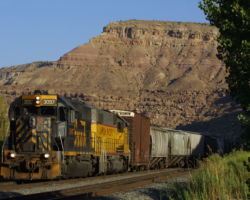
Helper & Soldier Summit – Fri-Sat, Aug 30-31, 2002
With the Montrose Local turned and headed back to Grand Junction at about 1330h, I finally managed to head back towards GJ and eventually Utah. Seeing at it was already well after noon, I really had no hopes of catching either the Potash Local or the returning Friday Dirt Train. After all, the Potash turn was usually back at Brendel (where the Cane Creek Branch joins the mainline) at latest by 1500h, and the Dirt Train is usually headed back between 1500-1600h. So, I put on a little driving music, reset the scanner to the mainline frequencies, and headed west.
Not quite as regular as clockwork, I met the Potash turn just east of Thompson at nearly 1530h. Based on the radio chatter, it sounds like it took quite a white back at Brendel switching out tankers of fuel for the local truck stop. As has been typical lately, the turn was powered by a pair of UP SD40-2s. Even though these could be considered on the endangered list in their own right, there are still a lot more of them than there are Rio Grandes floating around. I’m sure I’ll regret not shooting them someday, just as I regret not shooting the solid sets of CNW Dash-8s and the gaggles of BN SD40-2s that used to run the Chicago-Minneapolis route. That’s the odd thing about railfanning, at least for me; I tend to go after the rare and unusual today, missing out on what will be rare and unusual tomorrow – at least until tomorrow becomes today and the whole vicious cycle repeats. So, got it – pass on one pair of snoot-nosed UP SD40-2s.
Everything between Brendel and Mounds might as well have been part of Tennessee Pass – absolutely dead quiet. Miles and miles of desolate desert railway with dark signals and only the occasional string of stored cars to break the long stretches. An hour and some odd minutes later, though, just as I passed the road down to Mounds, I heard the afternoon Dirt Train call in to clear up his Sunnyside Branch warrant. First thought: Hot damn, he’s running late, I can still catch him on the way back to Helper. Second thought: Crap, I just shot past the road at 70 MPH, and there’s too much traffic to turn it around. Third thought: There’s a gigantic coal-hauling semi about to pull out in front of me. AAAGGH!
Fortunately, I realized that it was probably smarter to go up to Wellington and work back down Wellington Canyon than to try to catch up with him from the back. Also, probably driven either by my colorful language or sheer force of will, the truck managed enough speed up the hill to pass the offending tractor-trailer. A few clouds were starting to set in a bit by the time I actually got down into Wellington Canyon, but the light still wasn’t that bad. I set up my shot on a hill I’d had my eye on for several trips and waited. The wait wasn’t to be long, though, for as soon as I reached the top three headlights appeared in the distance. It didn’t take long and the four motors were accelerating past me (Photo #32) – the track speed goes up near this curve, and I’m sure the crew was anxious to get back to Helper and tie up for the night.
I did manage to beat them back to Helper, but only because the dispatcher held them at Maxwell while a westbound cleared up through the yard. As soon as they had the train cut off and tied down, Rio Grande 5401, 5371, 5377, and 5390 were parked back at the engine shed for the night. (Photo #33) This left only one question – where was 5349? A week before I’d arrived, Union Pacific had dropped DRGW 5349 off at Helper for some unknown reason. For the first time in nearly 18 months, Helper, UT, was once again home to more than the basic four tunnel motors that seem to have taken up permanent residence there.
My excitement about possibly seeing all four operate together was suddenly starting to fade – perhaps 5349 had been whisked away again as quickly as it had come; I hadn’t checked the trace since Thursday. There was always the possibility it got put into helper service, but that seemed unlikely until I remembered hearing that a big GE had suffered a crankcase explosion earlier in the day. I was still quite a ways out from Helper, but I managed to make out that much on the radio. Still, on the off chance that it had gone up the hill, I should check…
Twenty minutes later I was pleasantly surprised that, sure enough, sitting on the house track at Soldier Summit was 5349. It was just sitting there, all by itself, with nobody around. Apparently it had been tacked on some train earlier in the day that needed a little extra shove and was subsequently dropped at the Summit. I couldn’t resist walking up to it and getting photos from all around. 5349 was the last surviving T-2 still in Rio Grande paint that I don’t have photos of, and consequently I was very pleased that it was the unit chosen to add to the Helper fleet. (I learned later that a few minutes after I walked back to the truck and headed back to Helper, an eastbound light power move stopped to collect the unit. Sometimes my luck in timing amazes even me.)
Meanwhile, down at Helper, a coal load (UP 6618 west) out of Castle Valley was headed into Helper to pick up manned Utah helpers. Don’t let the power fool you – despite the fact it’s powered by large UP AC motive power, this train is 100% Utah Railway. While I was out there, five of the Utah’s six very unique MK5000Cs were out of commission due to broken crankshafts and the resultant engine damage that comes with that. I believe that the Utah was using run-through UP power to help it through its power crunch, as this is the usual IPPX train that I normally see powered by 4-5 Utahs. Regardless, there was some amount of bitter irony watching a UP-powered coal train drag to a stop and have six manned helpers inserted (Photo #36) while the old Rio Grandes sat quietly over by the engine shed. It was still good, though, to watch six second generation diesels (two SD40-2s, three Aussie SD50s, and one ex-ATSF SD45) blast out of Helper. Those things sound at least twice as big as an SD90MAC, and while I don’t envy the crews that have to ride them up the hill, it’s a great sound as you’re standing trackside. With that, the sun was dropping over the mesas and my stomach was reminding me that it wanted a little attention after I’d ignored it through breakfast and lunch. So I went back, checked into the local Price River National 9, grabbed the biggest hunk of beef on a bun that I could from A&W across the road, and retired for the night to review the day and catch some sleep.
Saturday dawned way too early, that’s all I’m going to say. Finally, a day I could sleep in, and what do I do? Get up an hour before I usually do to chase a train full of garbage across the desert. Makes sense, right? Based on who had reported in as coming to Helper, I expected a full foaming contingent to be waiting upon my arrival to the yard – Robert Harmen and David from Grand Junction; Jim Belmont, Steve Seguine, and Dave Gayer from the Salt Lake area; Kevin Morgan of DRGW.ws fame, and myself. Of those, only Jim’s group of three was sitting there in the blue VW Bug when I pulled in. Who knew – maybe they were all out in the desert already set up and waiting. Still, just as I arrived they were pulling the power off the engine track (Photo #37) and preparing to get underway. Mark up another one to impeccable, yet completely accidental timing.
It was going to be a beautiful morning to get a few shots down south of Wellington canyon. Rather than wait around, I said goodbye to Jim, Steve, and Dave, and hit the road in an effort to get set up well ahead of the train and stake out my spot before anyone else got any bright ideas. Just south of Wash, I did see that Robert and David were setting up high on one of the hillsides. I intended to return back to near my spot from the previous afternoon, so I didn’t stop to talk. The spot in question is near MP607, I believe, and is a hill with two cuts through it – the one the modern mainline uses, and the one the old main used to use. The whole thing is on a sweeping curve with short trestles at both ends of the cut. I parked by the east/south end and lugged the two cameras up to the top of the hill.
I was a bit concerned initially, as some high clouds were slowly rolling through my sunlight, but by the time 5390 east came around the curve it was no longer an issue. My favorite photo of the trip comes in with Photo #38 – the Saturday morning Dirt Train in what can only be called perfect light. The parting shot wasn’t bad either (Photo #39). Note the old alignment visible off to the right in #39 – several of these realignments are visible out in the desert south of Wellington, including several long-missing bridges. Oh yes, and if you like the still photos, you’ll love the video – Photo #40.
After a brief stop at Mounds to let the train clear the grade crossing, the pursuit was back on. Up, down, around, and over the hills towards the Grassy Creek trestle. Helper had suffered quite a rain and hailstorm on Thursday night, as evidenced by all the leaves on the ground around town. What I hadn’t connected with it, though, is that Grassy Creek might actually be a creek, rather than just a dry streambed. The road and stream cross under the railway at the same point, which usually isn’t a problem because it’s just a dry wash. That reality that it now wasn’t came into perfect focus when Jim’s blue bug came to a rather abrupt stop in front of me. I looked up to see not only water in the streambed, but deep ruts through mud on the other side. Oh goody, just what I wanted… I stopped, dropped it into 4WD, went around Jim and hit the mud running, hoping it would carry me through without problems. Like any big truck, the Yukon is okay only as long as you’re still moving. Once you stop moving, you start sinking, and from that point, you’re screwed.
There was a lot of spinning and sliding, and the tires were chewing out mud left and right, but I did make it through. (Photo #41) The SLC group had abandoned the Bug and crossed on foot to get their shots. Knowing that the train was only making 15 up the branch, but those guys would never make it through or around in time, I cleared as much junk from the back seat as I could and went back for them. My only comment to them was, “If something crawls out from under the seat, just throw it in the back with the rest.” Now for the bad news. Jim was out of film, and his film was in the car on the other side of the mudhole. So I backed up, put it back in four-wheel drive, and floored it. Aside from hitting it a little hard and the wave of mud that rose up and over the truck, everything came out fine for both trips through the mud. And Steve, if you’re out there reading this, I’m sorry you had to be a front seat passenger to my driving, especially out muddin’. As I mentioned later – SUVs as God intended them be used.
Our first stop up the line was at a cattle guard where the line meets the road again on the way to Sunnyside (just east of Banning). Actually this one was Steve’s suggestion, to be perfectly honest. I would usually shoot further up the line, just because it’s closer to the road and it gives me a bit more lead time. However, I’m also not used to railfanning with three other guys, all of whom insist upon torturing me by talking about F-units working Soldier Summit. I guess that pretty well dates me. Either way, I made the mistake of trying to grab the video camera and tripod and still manage to stumble across the tracks in time to get everything set up. With track speed at 15 MPH or so, I still had no problems making it through the desert shrubbery and up across the line in time, but due to complications with the tripod and a lack of level ground I didn’t manage to get the video camera set up. Honestly, I almost wasted so much time messing around with it that I nearly missed the train with my actual camera. Eventually I chucked it into a nearby bush for a soft landing and grabbed Photo #42.
From there, it was back in the car and up to the usual spot at the grade crossing just west of the ECDC landfill. It’s the last place that the Sunnyside Branch is publicly accessible, and it’s also the easiest point on the line to get a good morning shot. Once again, it was just the four of us, and one lone guy in a blue Ranger on vacation from Iowa. (Wahoo! Another fellow Iowan, I’m not alone!) The wandering Iowan had actually been around since the previous afternoon’s Dirt Train run, but it seemed like we were always going opposite directions. None of us had any idea what happened to Robert and David – I was just hoping they weren’t stuck in the mud. That particular crossing isn’t the most creative photo opportunity in Utah, but it gives consistently good results. (Photo #43)
With the strong morning light, catching any shots of the four coming back out of the facility at the grade crossing just wan’t going to be possible. Too greatly backlight, and no real way to make that work for us. So, after talking about it for a minute, we all piled back in the truck to head back for “the bridge”. After a slight delay for the driver to offload the photos from the camera to the laptop, we were off. The only problem was we weren’t exactly sure which bridge we were off to – the US 6 bridge or the Grassy Creek trestle. Somehow as we went over US 6 I decided it meant that bridge and we stopped to walk back to the overpass. The lighting was good, and it would be an excellent chance to get a shot of the four motors with the now unused Banning loadout – or at the least get run over by one of those tractor-trailers zipping by. The last time I’d tried to photograph from the bridge I’d lost a leather jacket to it. I had to jump the guardrail to avoid being hit, and snagged a sharp corner. I was certainly hoping this time would be a better-spent effort.
After yet more discussion of those mysterious F-unit creatures that came long before me, some discussion of anthills, killing time, scouting out a hubcab in the brush, killing yet more time, and discussing Utah railfanning, we were at last rewarded. With the passage of the four motors (in excellent, pure morning light – Photo #44), I returned through the mudhole and dropped off Jim, Steve, and Dave at the car. The plan was to make another catch or two on the way back and then work on lunch once we arrived in Helper. Due to their rather low speeds, I actually managed to catch the light power move again rejoining the main at Mounds (Photo #45).
The SLC-mobile got ahead of me at this point, and I quickly followed behind them. I guessed there was a small chance of one more photo op before the track speed rose around MP 607. However, just as I was starting to get ahead of the units, I noticed the SLC group setting up in the distance. Since trying to pursue the power any further would kick up a huge cloud of dirt, I stopped the Yukon in the bottom of a wash (so it would by below grade level and out of photos) and sprinted over to the line for one of those “why not, fire off a couple” shots. I hadn’t anticipated getting anything good, but as it turns out it’s one of my other favorites from the trip. (Due to limited space, it’s in Chapter 5). From there, it was back to Helper.
Not everything goes as planned, and once again the DS held the returning power short of the Helper Yard, near Maxwell, for something to clear up. Thankful for the break, I stopped near Spring Glen, walked to the “right” side of the tracks and waited. Within a few minutes, the line was once again clear and the DS lined them on in. Wasting no time on their new signal, the crew brought the four units past at a very good clip. (Photo #46) From there it was on into Helper. While I anticipated catching them coming into the yard, I happened to notice Robert’s Blazer at Sunbonnet Signal Systems – a new small railfan shop and model signal manufacturer in Helper – so I decided to stop in. I’d seen the shop the night before, but it had obviously been closed by the time I arrived in town. It’s a small hole-in-the-wall place at 160 South Main Street, and their specialty is Rio Grande-prototype (Type D and Type SA) signals in HO scale. All I have to say is do they ever look good – some of the best model signals I’ve ever seen. Supposedly there will be an article on them in the next Prospector, so keep an eye out for it.
Either way, stopping in gave me the opportunity to properly introduce myself to Robert and David – an opportunity that had been missed in the hurry of setting up for the morning Dirt Train. Eventually they left after a Utah that had just finished loading at Wildcat, and shortly after the Jim & Company wandered in. After they’d thoroughly looked over everything and purchased a few items, we headed down to Grogg’s Cafe (along Carbonville Road just north of Price) for lunch. For those looking for somewhere to eat in the area, Grogg’s is highly recommended. Great food and drink, served trackside so you don’t miss much.
Speaking of not missing much, as lunch was winding down (we were all done eating – it was just a matter if we were done shooting the bull yet), UP 6665 came through westbound with a loaded UP coal train – no IPPX here. This one had a real UP crew, distributed power units, the whole bit. However, it had a single unit on the back. I’d been told by the Sunbonnet shop owner that 5349 had gone up on a similar train the night before, slaved to the back DP unit, and had been doing so semi-regularly. How true this is I don’t know, but it seems very plausible. Regardless, rather than risk missing something good, we all headed out and went our separate ways for the trip.
By the time I’d fueled the truck and gotten ready for what could be a very interesting chase up the grade, the train had the yard, but all five motors were still there (Photo #47). They hadn’t stopped to pick up a helper – darn. However, just as I’d turned around to give up, a call came in saying they were already down to 5 MPH and dropping. Something was wrong, very wrong, as they hadn’t yet really begun the climb in earnest. Bad for the crew, bad for Union Pacific, but possibly a great day for the railfan. Forgetting that I’d seen this before, my hopes once again rose that the helper fleet would be called into service once again. After waiting nearly forty minutes at Castle Gate (Photo #48), the problem was finally found and resolved – someone forgot to connect the DP unit in the swing helpers to the other two AC4400s, meaning that they had almost 9000hp offline. Odd, this happened the last time I was out. You’d think somebody would learn to check that stuff.
I met up with Robert again near Castle Gate, and he tipped me off to a block of Utah helpers returning down the hill light, so I went up to sit near the Kyune tunnels and try to photograph them. I’d actually hoped for a meet between them and the approaching UP 6665 west (still struggling to get up the hill), but in fact I would be about thirty seconds off. Still, a decent set of Utah helpers (Photo #49) might eventually be on the way out, too, depending on what new parent G&W does with the road. At the very least, they probably won’t be grey-yellow-red much longer. After that, I headed up and over the hill to go find the train these helpers had been removed from.
Even after stopping at the convenience store at the summit for something to drink, I still caught up with the westbound coal load near Gilluly. What I didn’t expect was that it was lead by UP 5824, an AC4400CCTE flagged “Building America” unit, followed by two SD9043MACs. Lacking any good photo location close by, I got ahead of it by quite a bit and waited in the weeds near Detour, UT – where US 6 crosses the line on a bridge. After a small eternity (which probably seemed longer due to the revenge of the beverage from the summit), the signals finally clicked to life and within minutes 5824 was cruising by with heavy dynamics set up. (Photo #50) There’s just nothing quite like the whine of megawatts of electricity being burned off as heat, added to the airbrakes being set on 480-ish axles of coal drag.
I’d actually intended to follow UP 5824 on down the canyon to Spanish Fork and Springville, but somewhere on the way down I met up with UP 6816 east – an empty coal train headed back up the hill. There wasn’t anything really remarkable about the train, but I figured it was essentially going my way. I wasn’t really that interested in getting too far from Helper, just in case 5349 did get pressed into service. However, on the way back, I stopped at Gilluly to catch the units on 6816 and chat with some other railfans that happened to be stopped alongside the road. As it turns out, they were returning to LA from a trip that had taken them through Montana, Wyoming, and Idaho, and had just come down onto Soldier Summit on a whim. Pretty good hunch – this was the busiest I’d seen the line in a year or two. We talked for a while about their travels and operations on the former Grande when UP 5830 came along – another flag unit – and trailing it was 5834, yet another flag! I have to say it was the most I’d seen of the flags to that point, but it really was too bad they were in coal service. They get so grimy and dirty working through the Rockies.
Picking up from the radio that nothing else, east or west, was expected for some time, I continued my drive back to Helper. The first train, UP 6816 east, was having problems near Colton, and 5830 had been run around him. Thinking I might finally get a shot I’d wanted at Kyune for some time, I parked the truck at the little roadside park near the road down to Kyune and hiked back into the trees. After again what seemed like an eternity (including half of that eternity with the train in sight, but stopped just a little too far back with more problems), I did finally get the shot I’ve been eyeing. (Photo #51) Continuing back to Helper, I picked him up yet again near the east/south portal of the Kyune Tunnels (Photo #52). For anyone wondering how to get that far down, there’s a narrow, rutted shelf road running out of the parking area above the tunnels down to the grade level. A car can make it (as I met three fishermen down there with a sedan), but I certainly wouldn’t try it in one. With a truck? No problem.
I went back to Helper, shot 5349 basking in the last rays of the sun (Photo #53), and called it a day. Somehow seems fitting for these last five – it’s not quite twilight for the tunnel motors yet, but it’s definitely their last good hours. Old warriors that ten years ago ruled the Colorado Rockies, five or six at a time, but now were demoted to hauling trash through the Utah desert. Only seven intact ones left as I write this. I suppose it’s better than the scrap pile, or even being parked for preservation, but somehow it doesn’t seem a fitting end. What I wouldn’t give to see all seven on one last big manifest over the old Rio Grande.
Despite grabbing a chicken sandwich and heading back to the room for dinner and some brain-numbing TV, I wasn’t quite satisfied yet. It seemed like I was wasting time that could be better used doing, umm… something. So I headed back up into the Price River canyon after dark to give some night photography a shot. I’d planned to use Amtrak’s westbound California Zephyr as a subject, but due to problems perfecting the exposure with a digital camera, combined with the wind blowing the tripod around, it just didn’t work out. Oh yes – the other problem was that I kept trying to walk over the edge of the cliff. I eventually got a couple of emergency chemical light sticks out of the truck and marked off the edge, just so I’d stop doing that… As luck would have it, though, what I believe was MROGJ (the Roper-Grande Junction manifest) came down the canyon, providing a very interesting shot with Photo #54, shot from high above the Nolan tunnels. It’s definitely not the world’s greatest night shot – not even close – but I thought it was interesting enough to include.
Sunday – Homeward Bound
Sunday morning brought an overslept alarm. Initially I thought that would be okay, since the CV local usually wasn’t out that early. However, once I’d gotten dressed, checked out, and everything back in the truck, I heard 5390 call in from Wash for permission to switch. AIEEE! From there it was busting my rear out to Wash, just to see what was going on. As it turned out, they were going to be a while switching some empty coal gons back into the yard at Wash for storage. However, I did catch one runaround move at the Ridge Road overpass. (Photo #55) From there, based on the fact it looked like it was going to be a long, slow job, I decided to head out for home.
The trip home was really unexciting and uneventful. Between Wash, UT, and Glenwood Springs, CO, I saw exactly and precisely nothing. For that matter, I heard nothing but track maintainers on the radio. Even a quick stop in Grand Junction revealed little to nothing moving. However, east of GJ, near DeBeque, I started picking up radio traffic about a train having DPU trouble in Glenwood Canyon – to the point that it was blocking the main and Amtrak was being held at Glenwood. Again, bad for Amtrak, bad for UP, bad for the passengers, but it might make it a good day for the otherwise road-weary railfan. As I was passing through Silt, they’d gotten the DPUs back online with a computer reboot, and were moving it into the hole so both Amtraks could get around. Six (the eastbound Zephyr) was still holding at Glenwood, and Five (the westbound) was well into the Dotsero Cutoff. The scheduled meet point for the day was going to be Dotsero due to all the delays. Needless to say, I wasted no time getting through the canyon to Dotsero and got everything set up on the old highway bridge.
One interesting thing about the old highway bridge in Dotsero – it has plates at both ends marking it as the D&SLW railroad, with a construction date of 1934. I’m guessing that the D&SLW was the company that actually built the cutoff, but I’m not exactly sure. Still, it’s just another old, odd feature along the Rio Grande. After pacing on the bridge for half an hour, five did finally show up, with Amtrak 181 in the lead (Photo #56). Also of note was that Rail Ventures’ private varnish Bella Vista was riding at the end of the train, just ahead of the freight cars. (I’ve included a photo of it in Chapter 6.) A quick drive up and around the corner found me a great place to sit and wait on #5’s counterpart, #6. The wait wasn’t long, for within minutes Amtrak 80 and two other GEs came around the corner pulling for all they were worth (probably trying to make up time – Photo #57)
Between Dotsero and Bond, quite a bit of the Dotsero Cutoff is receiving ATCS signal communications links (as evidenced by the new antenna masts), and there are a great many new intermediate signals being installed as well. The new signals are two three-light hooded signal heads, similar to the old Grande units, except that they’re both mounted on the same mast, which is attached to a signal box. They’re also not being installed at the same locations as the old signals, but rather it looks like UP is trying to create new, longer blocks. There are photos of these guys in the next chapter as well. While I was able to pace Amtrak for a mile or two near the Bond end of the Cutoff, there really weren’t any photo opportunities due to speeds and times through the area. Amtrak is too darn fast, basically.
The next op was at Yarmony, where going through Bond had slowed him down ever so slightly. Yarmony was the site of a derailment two years ago that wiped out the west switch. Ever since then, it’s been a stub siding, and recently work has been approved to extend it and make it a useful length (previously it wouldn’t hold anything, except a light power move or a very small manifest). Evidence of this work can be seen in the earthwork off to the right of #6 as it winds along the mighty Colorado at West Yarmony (Photo #58). East of there, I didn’t catch up with it again until there was a slight delay for a meet with a coal empty at Azure.
Between Bond and Kremmling lies Inspiration Point, a particularly high outcropping along the road where it’s possible to see the east end of Azure (Photo #59) and the steepest, most rugged part of Gore Canyon (Photo #60) – and the railway, hundreds of feet below. I consider it one of the must see locations for railfans visiting Colorado. You don’t necessarily need to stay long, but it needs to be experienced in person to be appreciated. The D&SL almost didn’t build the line through the canyon. They had considered building over the divide to the north instead, due to the engineering problems of constructing the line and keeping it open from rockslides. However, they wisely chose the canyon route, and nearly 100 years later 20-30 trains per day are running over the segment.
After stopping in Kremmling for gas and nearly getting nailed by the town cop for speeding, I made the last stop of the trip at Fraser, CO, to catch 6 on its approach to the platform (Photo #61). Fraser is the last stop for the Zephyr before Denver, and it’s also close to the west portal of the Moffat Tunnel. To follow the line any further east takes an extensive amount of back-tracking, and it takes nearly 2-3 hours to get from one portal to the other by road. So, I hope you’ve enjoyed my babbling, or at the very least the photos. Thanks!
All shots in this trip report were taken with a Canon EOS D30 with a Sigma 28-80mm f3.5-5.6 lens or a Canon 75-300mm f4-5.3 IS/USM.
This work is copyright 2024 by Nathan D. Holmes, but all text and images are licensed and reusable under a Creative Commons Attribution-NonCommercial-ShareAlike license. Basically you’re welcome to use any of this as long as it’s not for commercial purposes, you credit me as the source, and you share any derivative works under the same license. I’d encourage others to consider similar licenses for their works.
